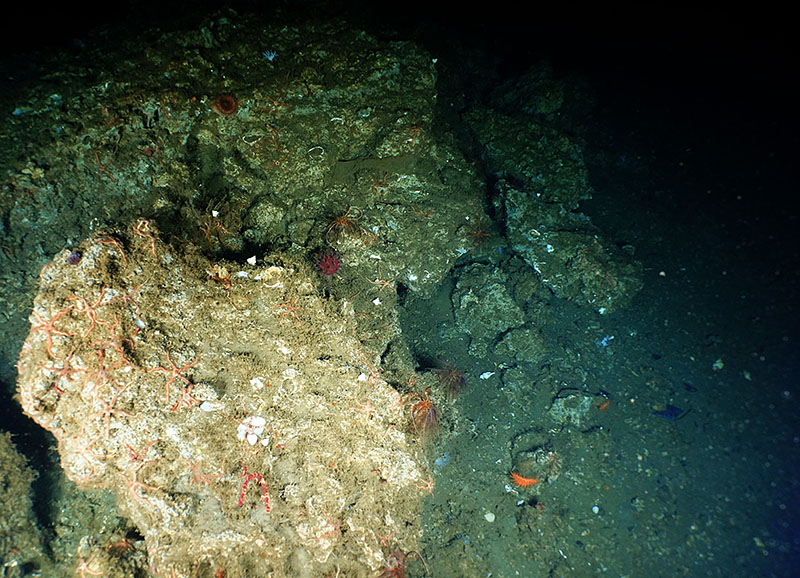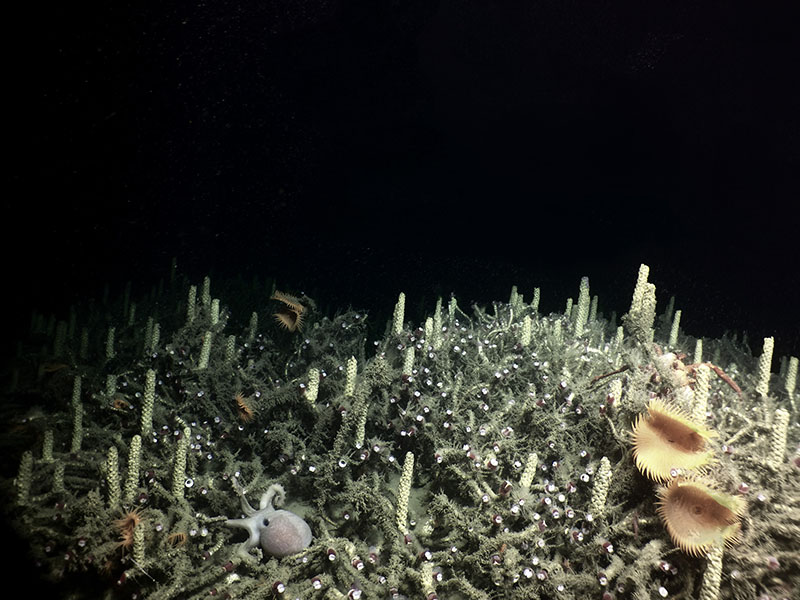
By Dr. Andrew Thurber, Assistant Professor, Oregon State University
September 26, 2020
Methane seeps are areas where methane leaks from vast reservoirs deep in the ocean mud. If that leak is big enough, it provides an energy source for microbes who can capture it, use it, and pass it on to other organisms. The first seeps were discovered in the early 1980s and have since been identified as habitats that occur throughout the world’s ocean basins, providing diversity to the ocean depths. But are they important? What do they do? What can they do in the future?
In part, seeps — or at least the microbes there — keep our planet inhabitable. Greenhouse gases in the atmosphere trap the Sun’s energy and keep the planet warm, but if they’re too concentrated, then it gets too warm. Many of us are most familiar with the greenhouse gas carbon dioxide due to its dramatic recent increase in the atmosphere from the burning of fossil fuels. However, methane is far more powerful than carbon dioxide, warming our atmosphere about 25 times more efficiently.
Thanks to microbes, almost all the methane that seeps out from the ocean floor is eaten before it reaches the atmosphere, limiting the rate at which our planet warms. While seep microbes capture and — as I like to think of it — diffuse methane gas, they also use the resulting energy to turn carbon dioxide into biomass. Just like photosynthesis at the surface, this biomass then fuels a whole food web.

Images like this are not unique. Seeps often co-occur with an abundance of organisms both unique to seeps and found elsewhere. Here is an example of many brittle stars, crinoids, squat lobsters, and anemones around an area of active seepage, on rocks created by the seep. Image courtesy of Ocean Exploration Trust - cruise NA121. Download larger version (jpg, 4.9 MB).
Some of my favorite aspects of seeps are what we often think of as non-material benefits. Eating greenhouse gases is one benefit. Capturing food to fuel the deep-sea food web is another. However, seeps also provide inspiration for art, opportunities for education, and the possibility to expand knowledge through scientific inquiry.

The diversity of animals that live at seeps is inspiring. On this cluster of Vestimentiferan tube worms, there are snail egg cases, an octopus, and a diversity of small organisms tucked in every crevice possible. Image courtesy of D. Fornari, WHOI MISO Facility, and Ocean Exploration Trust - Cruise NA095. Download larger version (jpg, 3.8 MB).
Seeps are full of strange critters. Worms with neither mouths nor anuses that harness chemical energy. Yeti crabs that dance to provide food for their microbial symbionts. Mussels that can be as dense as on a rocky shore line, but live at 1,000 meters (3,000 feet) depth and use bacteria to directly eat methane from the seafloor. Even the microbes that eat methane are odd — two different types work together to eat the methane, each taking on half the reaction (using methane and sulfate respectively) and then trading electrons to complete their meal. Studies of all of these creatures (be they microbe or animal) have expanded our knowledge of biodiversity and how organisms interact to shape the environment around them.

The diversity of life is often strange. These two worms, collected from a microbial mat at a seep clam bed, are not normally what people picture when they think of “worms.” This biodiversity can inspire art, including these two sketches of the worms imaged here, made by Oregon State University Microbiology graduate student Susie Cummings. The other fascinating aspect of the worm on the right is the tufts of chemosynthetic bacteria growing on its setae (hairs). While this type of worm (a maldanid) is frequently found at seeps, bacteria hasn’t been seen growing on it like this before. Art courtesy of S. Cummings. Microscopy courtesy of A. Thurber, Oregon State University; from cruise NA121, Ocean Exploration Trust. Download larger version (jpg, 2.5 MB).
The oddities at seeps have also impacted culture. Artists, movies, and TV shows have all used these discoveries to convey the majesty of the deep. These range from documentaries to art shows, books, and educational TV programs for kids. These pieces translate science to the world while exciting and inspiring people everywhere.
The next question is — what are some of the unknown impacts of seeps? How wide is their influence in the ocean? What discoveries will we make? And how do seeps fit into the balancing act between industrial and commercial use of the ocean and the maintenance of healthy ocean ecosystems? These are all questions we aim to advance.

With new live streams from the deep sea, everyone with an internet connection can join as scientists explore the deep sea. Image courtesy of ML Parker, Ocean Exploration Trust, NA121. Download larger version (jpg, 745 KB).
One of my favorite non-use benefits of ocean ecosystems is tourism. It wasn’t until just recently that we were able to take people along to the deep sea with us. Now, through live-streamed video feeds, almost anyone who wants to can join scientists as they explore the deep sea. I see this as the new age of ocean explorers, a collective of people around the globe who appreciate the deep sea for its diversity and inspiration, and who think of it not as a black unknown, but instead as a part of our society and global ecosystem.